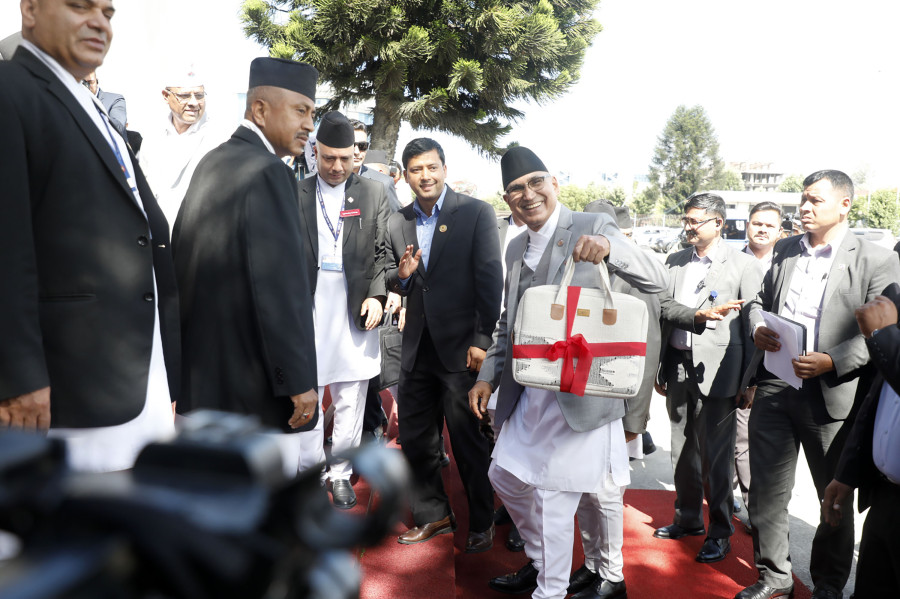Columns
A missed opportunity
The budget for FY 2025-26 lacks reforms and direction to drive change in Nepal.
Bhojraj Poudel
For the past 35 years, democratically elected leaders in Nepal have pledged to fulfil the aspirations of the people. Political parties routinely draft election manifestos with grandiose projections and ambitious promises. Each successive government tables programmes and policies for every fiscal year, outlining paths to take the country towards prosperity. Following these policy announcements, finance ministers present annual budgets, each claiming to offer a roadmap to transform Nepal’s economy. This tradition continued this year with Finance Minister Bishnu Paudel’s budget for fiscal year 2025-26.
Paudel’s 136-page-long budget speech, however, is moderate and lacks the ambition to drive transformative changes. It largely continues existing programmes and anticipates incremental progress rather than bold reforms. Given the current economic outlook, the budget’s implementation requires clear foresight and a strong commitment to elevate the economy from its current stagnation. If implementation remains weak, as has often been the case, Nepal’s economy will likely remain unchanged. Therefore, the major focus should be on laying a solid foundation for effective budget implementation.
A key concern is whether the government can meet the revenue target—around 70 percent of the total budget, Rs1.96 trillion—as envisioned in the budget and secure the necessary support from domestic and foreign actors to mobilise loans and grants to fill the budgetary gap. There are doubts about the government’s ability to attract sufficient funds from bilateral and multilateral development partners, which could result in a resource deficit. This is particularly concerning given Nepal’s ambitious development goals: Graduating from the least developed country (LDC) category by 2026, achieving the Sustainable Development Goals (SDGs) by 2030 and becoming a middle-income country by 2035. The government’s current struggle to fund recurrent expenditures and maintain basic state functions raises questions about its capacity to secure the finance required to meet these goals.
This budget sets a target of 4.61 percent economic growth for FY 2025-26—a moderate figure unlikely to generate the jobs and wealth needed to fund multiple development goals or to set the stage for rapid economic transformation. Without significant progress, millions of youth may continue to seek opportunities abroad, depriving the country of its most valuable resource. The paucity of a clear, ambitious vision in the budget risks perpetuating a cycle of underachievement and missed opportunities.
Meeting the revenue target
One of the hallmarks of the fiscal policies of East Asian countries has been the emphasis on broadening the tax base and improving compliance. For example, South Korea undertook comprehensive tax reforms in the 1970s, simplifying the tax code, reducing exemptions and investing in tax administration capacity. Even today, the South Korean government leverages technology to improve tax collection, improve filing systems and implement strict compliance measures. As a result, South Korea’s tax-to-GDP ratio has been steadily increasing, providing the government with the resources needed to invest in infrastructure, education and health.
Likewise, Singapore has excelled in tax administration. The Inland Revenue Authority of Singapore (IRAS) is known for its efficiency, transparency and use of digital tools to minimise tax evasion. Singapore’s approach combines low tax rates with high compliance, making it attractive for businesses while ensuring steady revenue streams for the government. The country’s ability to maintain a competitive tax regime while ensuring robust revenue collection is a testament to its effective fiscal management.
In contrast, Nepal’s tax system remains complex, with numerous exemptions and loopholes undermining revenue collection. Tax compliance is low, and the informal sector remains largely untaxed.
Government expenditure management
East Asian countries have also demonstrated prudent management of government expenditures. Taiwan, for instance, is known for its rigorous budgetary controls and emphasis on value-for-money in public spending. The government conducts regular audits, evaluates the effectiveness of programmes and reallocates resources to priority sectors. This approach has helped Taiwan maintain fiscal discipline while supporting economic growth.
Similarly, South Korea’s budget process is highly transparent, with extensive stakeholder engagement and public scrutiny. The government holds public consultations and allows parliamentary oversight. This transparency has fostered public trust and accountability, reducing the risk of waste and corruption. In addition, South Korea’s adoption of performance-based budgeting ensures proper resource allocation based on programmes that deliver measurable results, further enhancing the efficiency of public spending.
Nepal, on the other hand, faces persistent challenges in expenditure management. Budget execution rates are often low, with significant funds remaining unspent at the end of each fiscal year. Delays in project implementation, weak monitoring and lack of accountability contribute to this inefficiency.
Mobilising development finance
East Asian countries have been adept at mobilising development finance from both domestic and international sources. South Korea, for example, strategically used foreign aid and concessional loans in the early stages of its development, channelling funds into high-impact infrastructure and industrial projects. The government gradually shifted to domestic resource mobilisation as the economy grew, reducing reliance on external financing. This transition was supported by strong economic growth, sound fiscal management and a focus on building domestic financial markets.
Singapore has also proactively attracted foreign investment, creating a stable macroeconomic environment and maintaining sound public finances. The country’s sovereign wealth funds, such as Temasek Holdings and the Guaranteed Investment Certificate (GIC), have played a key role in managing public assets and generating returns for the state. Singapore has become a global financial hub, attracting investment and fostering innovation.
In comparison, Nepal’s reliance on external grants and loans remains high, but the inflow of funds from development partners has been inconsistent.
Way forward
Nepal needs to simplify and modernise its tax administration. The government could learn from East Asian experiences by simplifying the tax code, investing in digital tax administration and strengthening enforcement mechanisms. Modernising the tax system would not only increase revenue but also promote fairness and transparency, encouraging greater public trust in government institutions. A clear strategy should be developed to invest in digital infrastructure, reduce exemptions and strengthen enforcement to broaden the tax base and improve compliance.
Likewise, the Ministry of Finance must enhance budget transparency and accountability by engaging stakeholders and conducting regular audits to ensure the efficient use of public funds. Adopting best practices from East Asia—such as regular audits, performance-based budgeting and greater transparency—could help the country improve the effectiveness of its public spending.
One thing that the government has been failing to do is prioritise high-impact investments. So, there should be a focus on sectors that drive economic growth and job creation, such as infrastructure, education and technology. Additionally, promoting a culture of innovation and entrepreneurship can help unlock the potential of Nepal’s human capital. By investing in skills development, supporting small and medium-sized enterprises and promoting research and development, the government can create new opportunities for growth and employment.
To achieve its development goals, the government must strengthen its capacity to mobilise domestic resources, attract foreign investment and manage public assets more effectively. Developing a clear strategy for resource mobilisation, improving the investment climate and building partnerships with the private sector are critical for sustainable development.
Paudel’s budget for FY 2025-26 lacks the bold reforms and clear direction needed to drive transformative change. The path forward requires vision, commitment and a willingness to embrace best practices from around the world. Only through decisive actions and sustained efforts can we realise our collective aspirations for prosperity and progress.




 9.12°C Kathmandu
9.12°C Kathmandu
.jpg&w=200&height=120)












%20(1).jpg&w=300&height=200)

